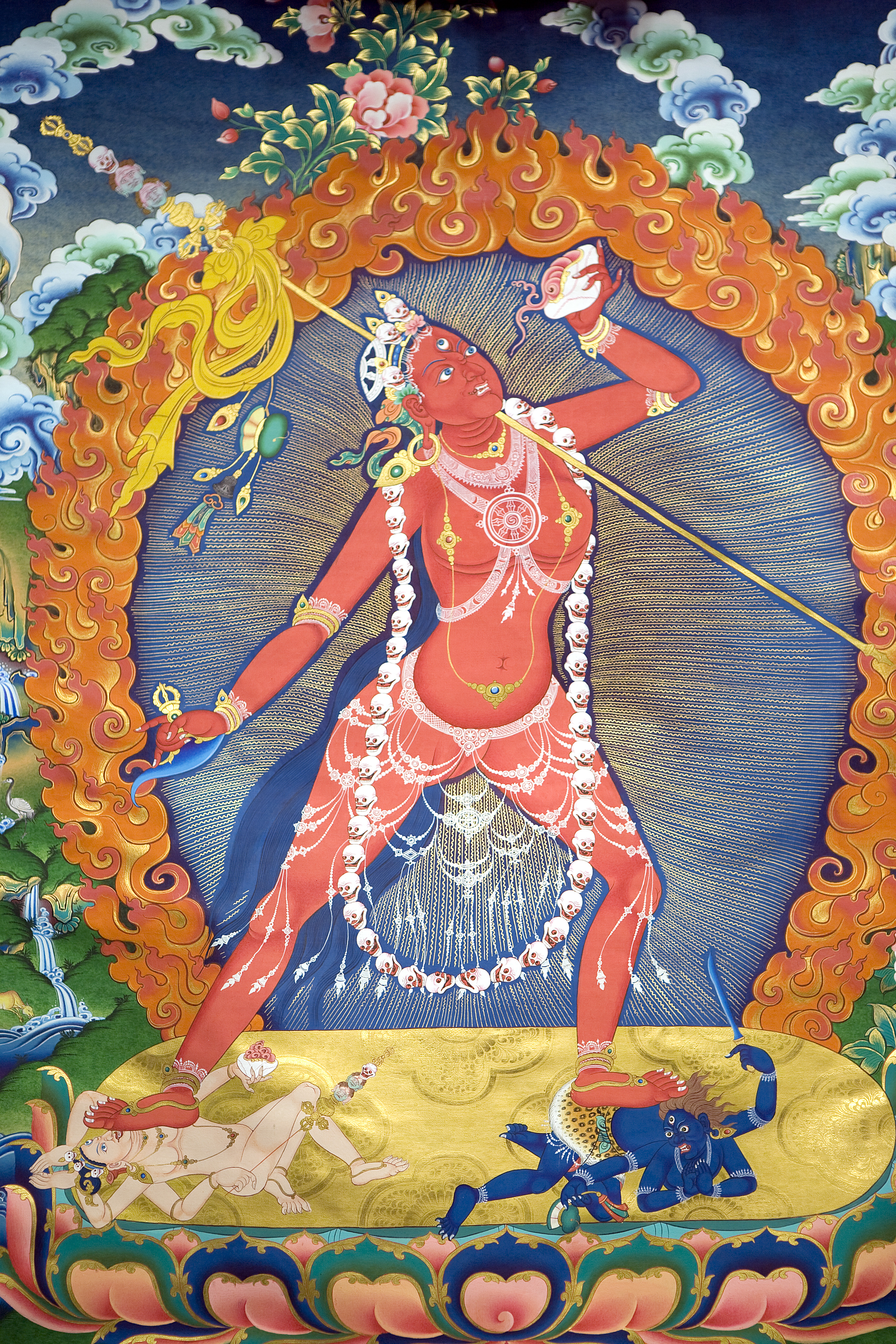|
Wrathful Deities
In Buddhism, wrathful deities or fierce deities are the fierce, wrathful or forceful (Tibetan: ''trowo'', Sanskrit: ''krodha'') forms (or "aspects", "manifestations") of enlightened Buddhas, Bodhisattvas or Devas (divine beings); normally the same figure has other, peaceful, aspects as well. Because of their power to destroy the obstacles to enlightenment, they are also termed ''krodha-vighnantaka'', "Wrathful onlookers on destroying obstacles". Wrathful deities are a notable feature of the iconography of Mahayana and Vajrayana Buddhism, especially in Tibetan art. These types of deities first appeared in India during the late 6th century, with its main source being the Yaksha imagery, and became a central feature of Indian Tantric Buddhism by the late 10th or early 11th century. Overview In non-Tantric traditions of Mahayana Buddhism, these beings are protector deities who destroy obstacles to the Buddhas and the Dharma, act as guardians against demons and gather together sentie ... [...More Info...] [...Related Items...] OR: [Wikipedia] [Google] [Baidu] |
Robert Buswell Jr
Robert Evans Buswell Jr. is an American academic, author and scholar of Korean Buddhism and Chinese Buddhism as well as Korean religions in general. He is Distinguished Professor of Buddhist Studies at the University of California, Los Angeles and founding director of the Academy of Buddhist Studies (불교 학술원) at Dongguk University, Korea's main Buddhist university. Education Buswell began his undergraduate education at the University of California, Santa Barbara and attended between September, 1971 and December, 1972. His focus was Asian Studies. Buswell then left the United States and became a Buddhist monk in Thailand, then Taiwan, and finally The Republic of Korea where he spent five years at Songgwangsa. This experience was related in his book ''The Zen Monastic Experience: Buddhist Practice in Contemporary Korea''.Princeton University Press"The Zen Monastic Experience: Buddhist Practice in Contemporary Korea"''Princeton University Press'' (US). retrieved 2014-03-15 ... [...More Info...] [...Related Items...] OR: [Wikipedia] [Google] [Baidu] |
Vajrayogini
Vajrayoginī ( sa, italic=yes, Vajrayoginī वज्रयोगिनी; , Dorjé Neljorma; mn, Огторгуйд Одогч, Нархажид, ) is a Tantric Buddhist female Buddha and a . The ''Vajrayogini'' cult dates back to the tenth and twelfth centuries. Vajrayoginī's essence is "great passion" (''maharaga''), a transcendent passion that is free of selfishness and illusion—she intensely works for the well-being of others and for the destruction of ego clinging. She is seen as being ideally suited for people with strong passions, providing the way to transform those passions into enlightened virtues. She is an Anuttarayoga Tantra iṣṭadevatā (meditation deity) and her practice includes methods for preventing ordinary death, intermediate state (bardo) and rebirth ( samsara) by transforming them into paths to enlightenment, and for transforming all mundane daily experiences into higher spiritual paths. Practices associated with her are Chöd and the Six Yogas of ... [...More Info...] [...Related Items...] OR: [Wikipedia] [Google] [Baidu] |
Dakini
A ḍākinī ( sa, डाकिनी; ; mn, хандарма; ; alternatively 荼枳尼, ; 荼吉尼, ; or 吒枳尼, ; Japanese: 荼枳尼 / 吒枳尼 / 荼吉尼, ''dakini'') is a type of female spirit, goddess, or demon in Hinduism and Buddhism. The concept of the ḍākinī somewhat differs depending on the context and the tradition. For instance, in earlier Hindu texts and East Asian esoteric Buddhism, the term denotes a race of demonesses who ate the flesh and/or vital essence of humans. In Hindu Tantric literature, Ḍākinī is the name of a goddess often associated with one of the six chakras or the seven fundamental elements ('' dhātu'') of the human body. In Nepalese and Tibetan Buddhism, meanwhile, 'ḍākinī' (also wisdom ḍākinī) can refer to both what can be best described as fierce-looking female embodiments of enlightened energy and to human women with a certain amount of spiritual development, both of which can help Tantric initiates attaining enli ... [...More Info...] [...Related Items...] OR: [Wikipedia] [Google] [Baidu] |
Dakini
A ḍākinī ( sa, डाकिनी; ; mn, хандарма; ; alternatively 荼枳尼, ; 荼吉尼, ; or 吒枳尼, ; Japanese: 荼枳尼 / 吒枳尼 / 荼吉尼, ''dakini'') is a type of female spirit, goddess, or demon in Hinduism and Buddhism. The concept of the ḍākinī somewhat differs depending on the context and the tradition. For instance, in earlier Hindu texts and East Asian esoteric Buddhism, the term denotes a race of demonesses who ate the flesh and/or vital essence of humans. In Hindu Tantric literature, Ḍākinī is the name of a goddess often associated with one of the six chakras or the seven fundamental elements ('' dhātu'') of the human body. In Nepalese and Tibetan Buddhism, meanwhile, 'ḍākinī' (also wisdom ḍākinī) can refer to both what can be best described as fierce-looking female embodiments of enlightened energy and to human women with a certain amount of spiritual development, both of which can help Tantric initiates attaining enli ... [...More Info...] [...Related Items...] OR: [Wikipedia] [Google] [Baidu] |
Kīla (Buddhism)
The ''phurba'' (; alternate transliterations: ''phurpa'', ''phurbu'', ''purbha'', or ''phurpu'') or ''kīla'' (Sanskrit Devanagari: कील; IAST: kīla) is a three-sided peg, stake, knife, or nail-like ritual implement traditionally associated with Indo-Tibetan Buddhism, Bön, and Indian Vedic traditions. The phurba is associated with the practice of the meditational deity (Sanskrit ''ishtadevata'', Tibetan ''yidam'') Vajrakīlaya (Tibetan ''Dorje Phurba'') or Vajrakīla (वज्रकील). Etymology Most of what is known of the Indian ''kīla'' lore has come by way of Tibetan culture. Scholars such as F. A. Bischoff, Charles Hartman and Martin Boord have shown that the Tibetan literature widely asserts that the Sanskrit for their term ''phurba'' is ''kīlaya'' (with or without the long ''i''). However, as Boord describes it, Mayer (1996) contests Boord's assertion, pointing out that eminent Sanskritists such as Sakya Pandita employed ''Vajrakīlaya''. Further, he ... [...More Info...] [...Related Items...] OR: [Wikipedia] [Google] [Baidu] |



.jpg)